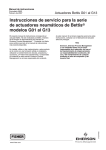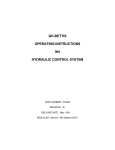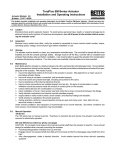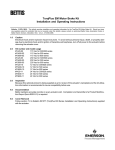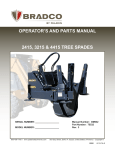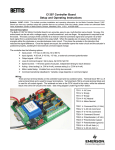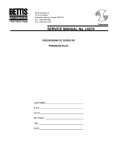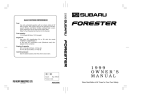Download bettis m11 manual hydraulic override system operating instructions for
Transcript
BETTIS M11 MANUAL HYDRAULIC OVERRIDE SYSTEM OPERATING INSTRUCTIONS FOR “HD”, “T”, AND “G” SERIES PNEUMATIC AND HYDRAULIC ACTUATORS PART NUMBER: 126858 REVISION: "F" RELEASE DATE: 18 September 2007 CONTENTS SECTION 1.0 – INTRODUCTION 1.1 1.2 1.3 1.4 1.5 General M11 Service Information Definitions General Safety Information Fluid Requirements Bettis Reference Materials PAGE 1 1 1 2 2 SECTION 2.0 – GENERAL OPERATION INFORMATION 2.1 2.2 Actuator Power Operation Actuator M11 Manual Hydraulic Operation 2 2 SECTION 3.0 - M11 SYSTEM FILLING INSTRUCTIONS 3.1 3.2 Double Acting Actuator M11 System fluid Filling Spring Return Actuator M11 System fluid Filling 3 5 SECTION 4.0 - M11 DISASSEMBLY INSTRUCTIONS 4.1 4.2 4.3 M11 Pressure Release Instructions M11 Reservoir Disassembly Instructions M11 Pump Disassembly Instructions 8 8 9 SECTION 5.0 - M11 REASSEMBLY INSTRUCTIONS 5.1 5.2 5.3 M11 General Reassembly Instructions M11 Reservoir Reassembly Instructions M11 Pump Reassembly Instructions 11 11 12 SECTION 6.0 – MODIFICATIONS 6.1 M11 Pump Handle Reorientation 15 Bettis P/N 126858 Revision "F" Page 1 of 15 SECTION 1 - INTRODUCTION 1.1 GENERAL M11 SERVICE INFORMATION 1.1.1 M11 is a compact modular hydraulic override system designed for use with Bettis Double Acting and Spring Return Actuators. The system incorporates a piston type hand pump and a fluid reservoir. NOTE: The M11 fluid reservoir is required because of the hydraulic cylinder differential, which is due to the inboard piston rod displacement. 1.1.2 MAINTENANCE: 1.1.2.1 Bettis does not recommend periodic field maintenance for the M11 Manual Hydraulic Override System (pump and reservoir). 1.1.2.2 The only time the M11 Manual Hydraulic Override System should be disassembled is when either the pump or the reservoir fails to perform its manual hydraulic override function 1.1.2.3 When possible the M11 package should be returned to the factory for maintenance. 1.1.3 Numbers in parentheses ( ), indicate the bubble number (reference number) used on the Bettis Assembly Drawing. WARNING: 1.1.4 Use a non-hardening thread sealant on all system threads. CAUTION: 1.2 1.3 Do not use Teflon tape on M11 system threads. Apply thread sealant per the manufacture's instructions. DEFINITIONS: WARNING: If not observed, user incurs a high risk of severe damage to actuator and/or fatal injury to personnel. CAUTION: If not observed, user may incur damage to actuator and/or injury to personnel. NOTE: Advisory and information comments provided to assist maintenance personnel to carry out maintenance procedures. GENERAL SAFETY INFORMATION Products supplied by Bettis, in its "as shipped" condition, are intrinsically safe if the instructions contained within this Service Instruction are strictly adhered to and executed by a well trained, equipped, prepared and competent technician. WARNING: For the protection of personnel working on Bettis actuators, this procedure should be reviewed and implemented for safe operation. Close attention should be noted to the WARNINGS, CAUTIONS and NOTES contained in this procedure. Bettis P/N 126858 Revision "F" Page 2 of 15 WARNING: 1.4 FLUID REQUIREMENTS 1.4.1 1.5 This procedure should not supersede or replace any customer’s plant safety or work procedures. If a conflict arises between this procedure and the customer’s procedures the differences should be resolved in writing between an authorized customers representative and an authorized Bettis representative. M11 Manual Hydraulic Override System Fluid Requirements: Hydraulic fluids, other than those listed in steps 1.4.1 and 1.4.2, should not be used without prior written approval of Bettis Product Engineering. 1.4.1 Standard and high temperature service (-20°F to +350°F) use Dexron II or Shell Tellus T-32 Automatic Transmission Fluid. 1.4.2 Low temperature service (-50°F to +150°F) Use Exxon Univis J13 or HVI 13 Hydraulic Fluid. BETTIS REFERENCE MATERIALS 1.5.1 1.5.2 Bettis M11 System Assembly drawing part number 127247. M11 with auto reset module uses additional drawing part number 135978. SECTION 2 - GENERAL INFORMATION 2.1 ACTUATOR POWER OPERATION CAUTION: 2.1.1 Place the M11 control knob (20-320) in the Auto position (middle position). NOTE: The control knob (20-320) is located in front and at the bottom of the M11 pump. CAUTION: 2.1.2 2.2 Power operation of the actuator with the M11 control knob in any other position than “AUTO” will cause fluid to overflow at the low pressure relief valve located in the reservoir outer end cap. Do not exceed the maximum operating pressure rating of the actuator. Apply an operating media, of the correct pressure, through a control valve to the actuator's power cylinder. ACTUATOR M11 MANUAL HYDRAULIC OPERATION 2.2.1 Shut off and exhaust the operating media from both sides of the actuator’s power cylinder. Bettis P/N 126858 Revision "F" Page 3 of 15 2.2.2 M11 Manual Hydraulic Operation as follows: 2.2.2.1 Double Acting Actuators - Select actuator rotation desired by placing the control knob (20-320) in the Manual CW or Manual CCW position. 2.2.2.2 Spring Return Actuators - Place the control knob (20-320) in the Manual position. 2.2.3 Operate the M11 pump handle until required valve position is reached. NOTE: When the actuator is fully stroked against the travel stops, an increased resistance in pumping effort will be noted. Continued operation of the pump simply circulates fluid through a relief valve. SECTION 3 - M11 SYSTEM FLUID FILLING INSTRUCTIONS 3.1 DOUBLE ACTING ACTUATOR M11 SYSTEM FLUID FILLING - Use either Refilling Method Number 1 (steps 3.1.2) or Refilling Method Number 2 (steps 3.1.3). Method number 1 is the best, most efficient and the recommended method. 3.1.1 Actuator position as follows: 3.1.1.2 Pneumatic and Hydraulic T series actuators: Apply pneumatic or hydraulic pressure to the inlet port located in the outer end cap of the actuators power cylinder, placing the actuator in the counter clockwise (CCW) position and proceed to step 3.1.2. 3.1.1.3 Hydraulic G series actuators: Apply pneumatic or hydraulic pressure to the inlet port located in the outer end cap of the actuators power module (cylinder), placing the actuator in the counter clockwise (CCW) position and proceed to step 3.1.2. 3.1.1.4 Pneumatic G and HD series actuators: Apply pneumatic pressure to the inlet port located in the outer end cap of the actuators power module (cylinder), placing the actuator in the clockwise (CW) position and proceed to step 3.1.2. 3.1.2 REFILLING METHOD NUMBER 1. - Refilling of the M11 Manual Hydraulic Override System is best accomplished using a pressure pump. NOTE: If a pressure pump is not available go to step 3.1.3 (method number 2) for the manual field service refilling procedure. 3.1.2.1 Shut off and exhaust the operating media from the actuator’s power cylinder. Bettis P/N 126858 Revision "F" Page 4 of 15 3.1.2.2 Remove the bleed plugs from the following locations: 3.1.2.2.1 G Series Actuators remove o-ring plug from the top of the outer and inner end caps. 3.1.2.2.2 T Series Actuators remove pipe plugs from the top area located on the outer and inner end of the hydraulic override cylinder. 3.1.2.2.3 HD Series Actuators remove pipe plug from the top area on the outer end of the hydraulic override cylinder and the cylinder adapter. 3.1.2.3 Disconnect the pump hose from the reservoir fitting, located close to the reservoir upper end cap (10-10), and connect the pump motor to the pump hose. NOTE: The M11 pump handle should be in the up position. 3.1.2.4 Place the M11 pump selector knob in the “Auto” position. NOTE: The pressure pump should not exceed 10 to 20 psi when force filling the M11 hydraulic system. 3.1.2.5 Start pumping the hydraulic fluid into the system with the pump motor. 3.1.2.6 When hydraulic fluid appears at the vacant bleed plug port hole located in the inboard area of the hydraulic override cylinder install pipe plug into the vacant port hole. NOTE: Use pipe dope on the bleed pipe plug. 3.1.2.7 When hydraulic fluid appears at the vacant bleed plug port hole located in the outboard area of the hydraulic override cylinder stop the pump motor and install pipe plug into the vacant port hole. NOTE: Use pipe dope on the bleed pipe plug. 3.1.2.8 Disconnect the pump motor from the M11 pump hose. 3.1.2.9 Connect the M11 pump hose to the fitting on the reservoir outer end cap (10-10). 3.1.2.10 Remove the breather (10-140) from the top of the reservoir upper end cap (10-10). 3.1.2.11 Fill reservoir to 1-1/2 inches from top of reservoir end cap (10-10). Note: Add fluid to the reservoir through the open port left vacant in step 3.1.2.10. 3.1.2.12 Apply pipe dope to breather (10-140) threads and install into the port in top of the reservoir inner end cap (10-10). 3.1.2.13 Return the M11 pump selector knob to the “Auto” position. With the M11 selector knob in the “Auto” position the actuator is ready for service. 3.1.3 REFILLING METHOD NUMBER 2. - Refilling the M11 Manual Hydraulic Override System without using a pump motor. 3.1.3.1 Remove breather (10-140) from the top of the reservoir end cap (10-10). Bettis P/N 126858 Revision "F" Page 5 of 15 3.1.2.2 Remove the bleed plugs from the following locations: NOTE: Only remove the pipe plugs located at the highest points, in the vertical plane, of the hydraulic override cylinder. 3.1.2.2.1 G Series Actuators remove o-ring plug from the top of the outer and inner end caps. 3.1.2.2.2 T Series Actuators remove pipe plugs from the top area located on the outer and inner end of the hydraulic override cylinder. 3.1.2.2.3 HD Series Actuators remove pipe plug from the top area on the outer end of the hydraulic override cylinder and the cylinder adapter. 3.1.3.3 Place the M11 pump selector knob in the “Manual” position. CAUTION: Never allow the M11 reservoir to be pumped dry of hydraulic fluid. 3.1.3.4 Fill reservoir to 1-1/2 inches from top of reservoir end cap (10-10). Note: Add fluid to the reservoir through the open port left vacant in step 3.1.3.1. 3.1.3.5 Start pumping the hydraulic fluid into the system with the M11 pump handle. 3.1.3.6 Stop pumping the M11 pump handle when hydraulic fluid appears at both vacant pipe plug ports located in the actuator’s hydraulic override cylinder. 3.1.3.7 Apply pipe dope onto pipe plug threads and install into the vacant pipe plug ports at both vacant pipe plug ports located in the actuator’s hydraulic override cylinder. 3.1.3.8 Fill the M11 reservoir 1-1/2 inches from the top of the reservoir. 3.1.3.9 Apply pipe dope to the breather (10-140) threads and install into the port on top of the reservoir upper end cap (10-10). 3.2 SPRING RETURN ACTUATORS M11 SYSTEM FLUID FILLING - Use either Refilling Method Number 1 (steps 3.2.1) or Refilling Method Number 2 (steps 3.2.2). NOTE: Method Number 1 is the best, most efficient and the recommended method. 3.2.1 REFILLING METHOD NUMBER 1. - Refilling of the M11 Manual Hydraulic Override System is best accomplished using a pump motor. NOTE: If a pump motor is not available go to step 3.2.2 (Method number 2) for the manual field service refilling procedure. 3.2.1.1 Actuator hydraulic override cylinder pipe plug removal. 3.2.1.1.1 G-Series – Remove one pipe plug from the spring cartridge hydraulic override outer end cap. Bettis P/N 126858 Revision "F" Page 6 of 15 3.2.1.1.2 HD and T Series – Remove the pipe plugs from the actuator hydraulic override cylinder outer and inner end. NOTE: Only remove the pipe plugs located at the highest points, in the vertical plane, of the hydraulic override cylinder. 3.2.1.2 Disconnect the pump hose from the reservoir fitting, located close to the reservoir inner end cap (10-10), and connect the pump motor to the pump hose. 3.2.1.3 Place the M11 pump selector knob in the “Auto” position. NOTE: The pressure pump should not exceed 10 to 20 psi when force filling the M11 hydraulic system. 3.2.1.4 Start pumping the hydraulic fluid into the system with the pump motor. 3.2.1.5 Stop the pump motor when hydraulic fluid appears as follows. 3.2.1.5.1 G-Series - At the vacant pipe plug port located in the hydraulic override end cap. 3.2.1.5.2 HD and T-Series - At both vacant pipe plug port located in the actuator’s hydraulic override cylinder. 3.2.1.6 Apply pipe dope onto pipe plug threads and install into the vacant pipe plug port as follows. 3.2.1.6.1 G-Series - At the vacant pipe plug port located in the hydraulic override end cap. 3.2.1.6.2 HD and T-Series - At both vacant pipe plug ports located in the actuator’s hydraulic override cylinder. 3.2.1.7 Disconnect the pump motor from the M11 pump hose. 3.2.1.8 Connect the M11 pump hose to the fitting on the reservoir outer end cap (10-10). 3.2.1.9 Remove the breather (10-140) from the top of the reservoir inner end cap (10-10) 3.2.1.10 Fill reservoir to 1-1/2 inches from top of reservoir end cap (10-10). Note: Add fluid to the reservoir through the open port left vacant in step 3.2.1.9. 3.2.1.11 Apply pipe dope to breather threads and install breather (10-140) into port vacated in step 3.2.1.9. 3.2.2 REFILLING METHOD NUMBER 2. - Refilling the M11 Manual Hydraulic Override System without using a pump motor. 3.2.2.1 Remove breather (10-140) from the top of the reservoir end cap (10-10). Bettis P/N 126858 Revision "F" Page 7 of 15 3.2.2.2 Actuator hydraulic override cylinder pipe plug removal. 3.2.2.2.1 G-Series – Remove one pipe plug from the spring cartridge hydraulic override outer end cap. 3.2.2.2.2 HD and T Series – Remove the pipe plugs from the actuator hydraulic override cylinder outer and inner end. NOTE: Only remove the pipe plugs located at the highest points, in the vertical plane, of the hydraulic override cylinder. 3.2.2.3 Place the M11 pump selector knob in the “Manual” position. CAUTION: Never allow the M11 reservoir to be pumped dry of hydraulic fluid. 3.2.2.4 Fill reservoir to 1-1/2 inches from top of reservoir end cap (10-10). Note: Add fluid to the reservoir through the open port left vacant in step 3.1.15. 3.2.2.5 Start pumping the hydraulic fluid into the system with the M11 pump handle. 3.2.2.6 Stop pumping the M11 pump handle when hydraulic fluid appears as follows. 3.2.2.6.1 G-Series - At the vacant pipe plug port located in the hydraulic override end cap. 3.2.2.6.2 HD and T-Series - At both vacant pipe plug ports located in the actuator’s hydraulic override cylinder. 3.2.2.7 Apply pipe dope onto pipe plug threads and install into the vacant pipe plug port as follows. 3.2.2.7.1 G-Series - At the vacant pipe plug port located in the hydraulic override end cap. 3.2.2.7.2 HD and T-Series - At both vacant pipe plug port located in the actuator’s hydraulic override cylinder. 3.2.2.8 Fill the M11 reservoir 1-1/2 inches from the top of the reservoir. 3.2.2.9 Apply pipe dope to the breather (10-140) threads and install into the port on top of the reservoir upper end cap (10-10). Bettis P/N 126858 Revision "F" Page 8 of 15 SECTION 4 - M11 DISASSEMBLY INSTRUCTIONS 4.1 M11 PRESSURE RELEASE INSTRUCTIONS NOTE: Shut off and exhaust the operating media from both sides of the actuator’s power cylinder. 4.1.1 Place the M11 control knob (20-320) in the Auto position (middle position). NOTE: Control knob (20-320) is located in front and at the bottom of the M11 pump manifold (20-10). NOTE: Using a means of capturing the hydraulic fluid that will be lost during the following steps. Use a bucket, tub, and large container, etc. 4.1.2 Remove the 1/8” pipe plug (10-100) from the reservoir bottom end cap (10-60). 4.1.3 Place the M11 control knob (20-320) in the Manual position. 4.1.4 Remove all the M11 pump assembly piping; SS Tubing (50) with male connector (40). NOTE: When removing the pump hose/tube fitting there will be a loss of fluid pressure. G & T Series actuators there is 250 psi pressure and HD Series actuator there is 33 psi pressure. 4.2 M11 RESERVOIR DISASSEMBLY INSTRUCTIONS NOTE: Review Section 4.1 M11 Pressure Relief Instructions before proceeding with reservoir disassembly. 4.2.1 Remove piping from port located in upper end cap (10-10). 4.2.2 Loosen socket cap screws (30-20) and remove the M11 reservoir from the M11 mounting bracket (30-90). 4.2.3 Remove breather (10-140) from upper end cap (10-10). 4.2.4 Remove acorn nut (10-70) from upper end cap (10-10). 4.2.5 Remove center bar assembly (10-30) from the upper end of the reservoir upper end cap (10-10). 4.2.6 Remove bottom end cap (10-60) from M11 cylinder (10-20) and center bar assembly (10-30). 4.2.7 Remove M11 cylinder (10-20) from upper end cap (10-10). 4.2.8 If required for replacement or maintenance remove low pressure relief valve (10-130) from elbow (10-90). Bettis P/N 126858 Revision "F" Page 9 of 15 4.2.9 If required for replacement or maintenance remove check valve (10-120) from pipe tee (10-50). 4.2.10 Remove elbow (10-90), pipe tee (10-50), and pipe nipple (10-40). 4.2.11 Remove Thread Seal (10-80) and washer (10-75) from upper end cap (10-10). 4.3 M11 PUMP DISASSEMBLY INSTRUCTIONS NOTE: Review Section 4.1 M11 Pressure Relief Instructions before proceeding with M11 pump disassembly. 4.3.1 Place the M11 control knob (20-320) in the Auto position (middle position). NOTE: Control knob (20-320) is located in front and at the bottom of the M11 pump manifold (20-10). NOTE: Using a means of capturing the hydraulic fluid that will be lost during the following steps, i.e. a bucket, tub, large container, etc. 4.3.2. Using a standard 1/4” Allen wrench remove o-ring plug (20-270) from the left side of the manifold (20-10). 4.3.3 Place the M11 control knob (20-320) in the Manual position. 4.3.4 Refer to assembly drawing sheet 2. To remove the check valve (20-40) from the manifold (20-10) move the pump handle to the up position and using a fast motion move pump handle down. Be ready to catch the check valve, as pulling the pump handle down will cause the check valve to come out of the manifold under pressure. There will be further fluid lost when the check valve (20-40) is removed. 4.3.5 Refer to assembly drawing sheet 1. Remove all the M11 pump assembly piping - male connector (40), and Tubing (50). NOTE: If the M11 pump is equipped with Auto Reset then do steps 4.3.6 and 4.3.7 and refer to Auto Reset drawing 135978. If not equipped with Auto Reset skip steps 4.3.6 and 4.3.7. 4.3.6 Remove male swivel elbow (40-20) from Bimba Cylinder (40-90). 4.3.7 Remove two socket cap screws (40-10) from bracket (40-50) and manifold (20-10). 4.3.8 Refer to assembly drawing sheet 1. Remove the four socket cap screws that retains the mounting bracket (30-90) to actuator housing and remove M11 pump assembly/bracket. 4.3.9 Refer to assembly drawing sheet 1. Remove four countersunk socket flat screws (30-100) that mounts mounting bracket (30-90) to pump manifold (20-10). Bettis P/N 126858 Revision "F" Page 10 of 15 4.3.10 Remove the M11 pump assembly from the M11 mounting bracket (30-90). 4.3.11 Refer to assembly drawing sheet 2. Remove four cap screws (20-110) from pump cover (20-20). NOTE: In step 4.3.10 the pump handle lever (20-90), pump rod (20-50), and associated parts will be removed with the pump cover (20-20). 4.3.12 Remove pump cover (20-20) from manifold (20-10). NOTE: To remove the pump cover (20-20) pull the pump rod (20-50) up out of the manifold (20-10) using a slight twisting back and forth motion. 4.3.13 Remove quick release pin (20-120) from pump handle lever (20-90). 4.3.14 Remove retainer ring (20-140) from pivot pin (20-130). 4.3.15 Remove pivot pin (20-130) from pump rod (20-50). NOTE: If the M11 pump is equipped with Auto Reset then do steps 4.3.16 and 4.3.17 and refer to Auto Reset drawing 135978. If not equipped with Auto Reset skip steps 4.3.16 and 4.3.17. 4.3.16 Remove one retainer ring (40-140) from auto reset lower pivot pin (40-130) located on the back side of auto reset bracket (40-110). 4.3.17 Remove flat washer(s) (40-150) from auto reset lower pivot pin (40-130) located on the back side of auto reset bracket (40-110). 4.3.18 Refer to assembly drawing sheet 2. Remove one socket cap screw (20-180) from the center of the M11 control knob (20-320) and remove the control knob from the control valve (20-190). 4.3.19 Remove the self-tapping hex head screws (20-240) from the position label (20-230). 4.3.20 Remove position label (20-230) from the control valve (20-190). 4.3.21 Remove the screws that retain the control valve (20-190) to the M11 manifold (20-10). 4.3.22 Remove the control valve (20-190) from the M11 manifold (20-10). 4.3.23 Using a standard 1/4” Allen wrench remove o-ring plug (20-250) from the right side of the M11 manifold (20-10). 4.3.24 Remove the relief valve (20-30) from the right side of the M11 manifold (20-10). 4.3.25 Using a standard 1/4” Allen wrench remove o-ring plug (20-270) from the bottom end of pump rod (20-50). 4.3.26 Remove check valve (20-40) from pump rod (20-50). Bettis P/N 126858 Revision "F" Page 11 of 15 SECTION 5 - M11 REASSEMBLE INSTRUCTIONS 5.1 GENERAL REASSEMBLY INSTRUCTIONS CAUTION: 5.1.1 Remove and discard all old seals and gaskets. 5.1.2 All parts should be cleaned to remove all dirt and other foreign material prior to inspection. 5.1.3 All parts should be thoroughly inspected for excessive wear, stress cracking, galling and pitting. Attention should be directed to threads, sealing surfaces and areas that will be subjected to sliding or rotating motion. Sealing surfaces of the manifold (20-10) and pump rod (20-50) must be free of deep scratches, pitting, corrosion and blistering or flaking coating. CAUTION: 5.1.4 5.2 Only new seals that are still within the seal’s expectant shelf life should be install into Bettis product being refurbished. Parts that reflect any of the above listed characteristics should be replaced with new parts. Before installation coat all moving parts with a complete film of lubricant. Coat all seals with a complete film of lubricant, before installing into seal grooves. NOTE: The parts and seals used in the actuator will be assembled using lubricant as identified in section 1 step 1.5.1. M11 RESERVOIR REASSEMBLE INSTRUCTIONS NOTE: Review Section 5.1 General Reassembly Instructions before proceeding with reservoir reassembly. 5.2.1 Refer to the assembly drawing SHEET 3. If disassembled, reassemble the following items; 5.2.2.1 Pipe nipple (10-40), pipe tee (10-50), elbow (10-90), low-pressure relief valve (10-130) and check valve (10-120) into one complete assembly. Bettis P/N 126858 Revision "F" Page 12 of 15 5.2.2.2 Using pipe dope install the items assembled in step 5.2.2.1 into upper end cap (10-10). NOTE: The pipe nipple (10-40) is installed into the upper end cap (10-10). Position the above assembly such that the assembly will not interfere with the center bar assembly (10-30). 5.2.3 Screw bottom end cap (10-60) onto center bar assembly (10-30). 5.2.4 Install reservoir o-ring (10-150) over the lip of bottom end cap (10-60). 5.2.5 Install cylinder (10-20) over the lip of bottom end cap (10-60). 5.2.6 Install reservoir o-ring (10-150) over the lip of upper end cap (10-10) then install entire upper end cap assembly (10-10) over the lubricated center bar assembly (10-30) and into the cylinder (10-20). 5.2.7 Install thread seal (10-80) and countersink washer (10-75) onto center bar assembly (1030). 5.2.8 Install and tighten acorn nut (10-70) onto center bar assembly (10-30). 5.2.9 Apply sealant to breather (10-140) and install into upper end cap (10-10). 5.2.10 Apply sealant to pipe plug (10-100) and install into bottom end cap (10-60). 5.3 M11 PUMP REASSEMBLY INSTRUCTIONS NOTE: Review section 5.1 General Reassembly before proceeding with M11 pump reassembly. 5.3.1 Install o-ring seals onto two o-ring plugs (20-270). 5.3.2 Install one check valve (20-40), with o-ring seal into the bottom of pump rod (20-50). 5.3.3 Install one o-ring plug (20-270) into the bottom of pump rod (20-50). 5.3.4 Install one check valve (20-40), with o-ring seal into the side of manifold block (20-10). Bettis P/N 126858 Revision "F" Page 13 of 15 5.3.5 Install one o-ring plug (20-270) into the side of manifold block (20-10). 5.3.6 Install Polypak seal (25-20) into the lower seal groove located on the pump rod (20-50). NOTE: Refer to assembly drawing sheet 2 Section A-A for correct orientation for Polypak lips. 5.3.7 Install Polypak seal (25-10) into the upper seal groove located on the pump rod (20-50). NOTE: Refer to assembly drawing page 2 for correct orientation for Polypak lips. 5.3.8 Install rod bushing (25-80) into groove located on the pump rod (20-50). 5.3.9 Install pump rod (20-50) into pump rod shaft of manifold (20-10). 5.3.10 Install rod wiper (25-30) into pump cover (20-20). 5.3.11 Install rod bearing (25-40) into pump cover (20-20). 5.3.12 Install Polypak seal (25-50) into pump cover (20-20). 5.3.13 Install o-ring seal (25–60) into pump cover (20-20). 5.3.14 Install pump cover (20-20) onto top of manifold (20-10). NOTE: When installing the manifold cover be careful in keeping the o-ring seal (25-60) in its seal groove. 5.3.15 Install four cap screws (20-110) through pump cover (20-20) and into manifold (20-10). 5.3.16 If removed install two pump links (20-60). Retain the two pump link to pump cover (20-20) using one link pivot pin ((20-150) and one retainer ring (20-140). 5.3.17 Tie the two pump links together using hex cap screw (20-220), two link pivot spacers (20-360), lockwasher (20-185) and elastic nut (20-280). 5.3.18 Install pump handle lever (20-90). 5.3.19 Retain pump handle to pump rod (20-50) using one pivot pin (20-130) and one retainer ring (20-140). 5.3.20 Install quick release pin (20-120) through the two pump links (20-60) and the pump handle lever (20-90). NOTE: The quick release pin can be installed in position 1, 2 or 3. Select position most appropriate for “effort” desired. 5.3.21 Install relief valve (20-30) into the right side of the manifold (20-10). 5.3.22 Install o-ring plug (20-250) into the right side of the manifold (20-10). 5.3.23 Install the control valve (20-190) onto the front of the manifold (20-10). Bettis P/N 126858 Revision "F" Page 14 of 15 5.3.25 Retain the control valve (20-190) to the manifold by install screws through the control valve body and screwing into the manifold (20-10). Tighten control valve screws to tight plus 1/4 turn. 5.3.26 Install the position label (20-230) onto the control valve. NOTE: The label for spring return actuators will be mounted with the two-position (“AUTO” or “MANUAL”) side of the label facing outward. If the actuator is a double acting model then the three-position (“MANUAL CW”, “AUTO” and “MANUAL CCW”) side of the label will be facing outward. 5.3.27 Retain the position label with one type “AB” self tap hex head screw (20-240). 5.3.28 Install the control pointer (20-200) onto the control valve (20-190). 5.3.29 Install the control knob (20-320) onto the control valve (20-190). 5.3.30 Retain the control knob (20-320) on the control valve (20-190) with one socket cap screw (20-180) & lockwasher (20-185) 5.3.31 Install the manifold (20-10) onto the mounting bracket (30-90) using four countersunk flat socket screws to retain the manifold to the mounting bracket. 5.3.32 Install the M11 package/mounting bracket (30-90) onto the actuator housing mounting pad using four socket cap screws. NOTE: If the M11 pump is equipped with Auto Reset then do steps 5.3.33 and 54.3.34 or if non Auto Reset M11 skip steps 5.3.33 and 5.3.34. 5.3.33 Install the male swivel elbow to the Bimba Cylinder (40-90). 5.3.34 Install the bracket (40-50) on the reservoir side of the manifold (20-10) and retaining the bracket with two socket cap screws (40-10). 5.3.35 Reinstall any piping that was removed from the M11 package. Bettis P/N 126858 Revision "F" Page 15 of 15 SECTION 6.0 - MODIFICATIONS 6.1 M11 PUMP HANDLE REORIENTATION 6.1.1 Remove the four socket cap screws (20-110) from pump cover (20-20). 6.1.2 Lift the pump cover (20-20) up from manifold (20-10) far enough to turn the pump handle to its new location. NOTE: Before putting the pump cover back down on the manifold be sure that the pump cover to manifold o-ring is still seated in it’s seal groove located in the pump cover. 6.1.3 Install the pump cover back down on top of the manifold. 6.1.4 Install the four socket cap screws (20-110) through the pump cover and into the manifold. 6.1.5 Tighten the socket cap screws (20-110) tight plus a quarter turn. ECN 19291 19330 19562 DATE 26 Oct 06 17 Nov 06 18 April 2007 REV C D E COMPILED CHECKED APPROVED BY * L.Ramirez C. Ross D. McGee * Signatures on file Bettis Actuator & Controls, Waller, Texas DATE 18 April 2007 18 April 2007 18 April 2007


















